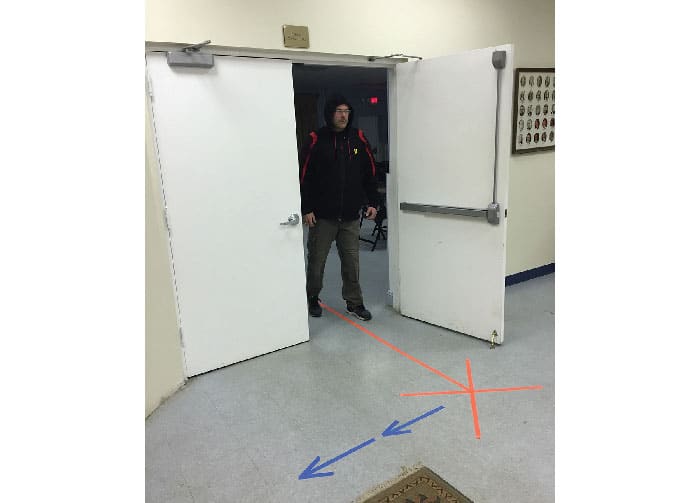By Paul Evancoe
You’ve been texting with your friends and not paying attention to your surroundings. You suddenly hear commotion close by and detect rapid movement coming at you. You’re being attacked! You’re startled—but what now? You need to get off the X. Your very survival depends on it!
What exactly is situational awareness, and what is the “X?” We’ll begin with situational awareness.
In cognitive psychology, “situational awareness” refers to the dynamic mental model of one’s constantly evolving situation. It is one’s constant awareness and understanding (your picture) of the surrounding environment and other situation-specific factors from which the ability to successfully enable rapid and appropriate decisions and effective actions is based. Situational awareness means maintaining continuous awareness of your surrounding environment—and to consciously and accurately recognize a potential threat(s) and take the action(s) necessary to avoid or mitigate a potentially negative outcome.

A person with good situational awareness is often said to have a “good feel” or a “good picture” of his surroundings and the situation he is exposed to at any given time. Therefore, good situational awareness encompasses the acquisition, interpretation, comprehension and utilization of (often dynamic) available information in order to anticipate future developments, make intelligent decisions and control risk. More simply, it means knowing what is going on around you so you can figure out what to do and not do if things begin to go bad.
Situational awareness is the tool used to stay off the X, or get off the X should you find yourself on it. So—what is the X? The X is the spot where the attacker aims to strike or is striking. Remember the Road Runner cartoons? Wile E. Coyote always stands on the X. That is the spot where he always gets clobbered. The same is true in real-life. The X is the spot you must avoid or move away from immediately.
This brings us to the OODA decision process originated (circa 1960s) by Col. John Boyd, USAF (Ret), a fighter pilot and military strategist. This dynamic process consists of four overlapping and interacting progressions: Observe, Orient, Decide and Act. While OODA has direct application in military strategy and operations, the first responder community and business, its importance to self-defense and getting off the X is paramount to survival.

Humans are wired from birth (although most don’t realize it) to employ a decision-making cycle; we observe-orient-decide-act to one extent or another. Some of us consciously hone this process, while many never gain a realization that they have it available to them. Regardless, anyone who can observe, comprehend their observations and rapidly react to unfolding events more quickly than an opponent, can “get inside” their opponent’s decision cycle—and in most scenarios, gain the advantage.
The prime objective is to survive by avoiding (the X) or defeating an attack. Therefore, your decision for a particular course of action is based on raw observations of the evolving situation coupled with analytical comprehension of the problem you’re addressing. This requires constant situational awareness.
According to Boyd, “the winning strategy is to get inside your opponent’s OODA loop, not just by making your own decisions quicker but also by having better situational awareness than [your] opponent, and even changing the situation in ways that [your] opponent cannot monitor or even comprehend. Losing one’s own situational awareness, in contrast, equates to being out of the loop.”
Boyd further distilled his thinking with his following explanation: “The OODA key is to obscure your intentions and make them unpredictable to your opponent while you simultaneously clarify his intentions. That is, operate at a faster tempo to generate rapidly changing conditions that inhibit your opponent from adapting or reacting to those changes that suppress or destroy his awareness. Thus, a hodgepodge of confusion and disorder occur to cause him to over- or under-react to conditions or activities that appear to be uncertain, ambiguous or incomprehensible.”

Can a person train to develop situational awareness? The answer is YES. All you need to do is pay attention to your surrounding environment. That begins at home and follows you every time you leave your home, while you’re out and about shopping, dining, running errands, on your way to work, while at work, at the gym—where ever you are. You consciously perceive your surrounding environment, comprehend its meaning and project your potential status within that picture with the aim of avoiding the X. If caught on the X in an attack, take immediate action to get off the X and rapidly move away from it. Always remember, fear is a reaction; getting off the X is a decision.
About now you’re probably asking how does one move off the X? To begin, the direction you choose to move factors into your survival. You need to quickly determine the direction(s) from which the threat is coming at you. At this moment, the key is to move laterally away from the threat axis if it’s possible to do so.
More simply, when the attack is heading toward you, you need to get out of the way. Even as little as one step, left or right, means the attacker must now adjust to you. Moving off the X, away from the spot where the attacker is striking, will increase your chance of survival. Practice this lateral movement at home in mental scenarios. Incorporate it into a daily training regimen both in thought and in deed. Practice your lateral movement to the point it becomes second nature. At that point you will react appropriately.
If you carry a concealed weapon or you keep a gun on your bed stand, practice drawing your (unloaded) weapon, pointing in the direction of the threat, while stepping laterally. If you can’t step laterally and get out of the way, step rearward as quickly as you can, opening the distance between you and the attacker, until you have room to move laterally away from the threat axis. In other words, pick a direction and get off the X. Find some cover and get behind it. You now have a fighting position and an instant advantage.

Several states have castle laws requiring that you attempt to vacate the threat area from an armed intruder (even inside your own home) before defending yourself with lethal force. Moving off the X will provide a justification if questioned by police. While tucked in bed and surprised, moving off the X may be difficult to accomplish, but not impossible with some practice.
Dry-fire practice with your unloaded firearm in your home. Begin by identifying all potential threat entry points and cover locations around the house. Cover points need to consider the fact that bullets easily penetrate furniture, drywall and hollow doors. Cover locations need to be reinforced points that bullets won’t readily penetrate. Work backward identifying these points to the location where you intend to make your stand using lethal force. Practice by taping paper pie plates along your path of retreat to represent your target(s) and dryfire on them as you move. Practice this drill under all lighting conditions and all times of the day and night when you might have to execute such movement for real. You can’t practice this drill too many times. Practice until it becomes muscle memory (second nature).
If you have the luxury of being able to practice getting off the X on an indoor or outdoor (better) range where you can draw and shoot while moving laterally away from the target, practice this evolution going left and right of the target. Practice your draw and your engagement shots while executing your lateral move. Practice this technique until you can reliably hit your target(s) at various distances. Practice the technique engaging several targets on two or more separate threat axis and distances from you. Practicing from a static position without drawing and moving, which is what most ranges demand, accomplishes little with regard to your readiness. Previously described dry-fire rehearsals in your home will accomplish more.
When you’re out and about in public, constantly identify potential threat scenarios and cover points like columns, corner walls, curbs or parked vehicles that you can crouch behind or fight from. Visualize your lateral movement to these locations and leap-frog away from them to another cover location nearby, and another, and so on to avoid the X. If you can walk through this scenario to practice your potential path to cover, do so.

Finally, for you to have the utmost situational awareness you must be constantly alert. How many times do we get to work and don’t remember the drive there or anything about the subway ride? This zombie-like state of mind is known as being in the “white.”
You go through your daily routine more or less numb to your surroundings for the first hour (or more) of the day. As you slowly wake up, your perception of the things surrounding you increases. This state of mind is known as being in the “yellow.” You’re alert enough to react but not hyper-sensitive to sounds, colors, movement, etc., and you’re not analyzing your surroundings for threat identification and counter-threat escape or evasion. When you’re in the “red” you’re most alert, and you’re ready to react appropriately.
We all subconsciously transition through these white, yellow and red states of awareness on a daily basis. The problem is that many of us never leave “yellow” unless “red” is scared into us. There is a way to train yourself to make the transitions consciously. The military and law enforcement use a conscious method that moves them to their highest state of awareness. They practice ramping up from “white” to “yellow” before leaving their home. This is achieved by consciously becoming fully awake.
Mental drills, like watching the morning news or listening to news radio and analyzing what you’re seeing and hearing work to move you from white to yellow to red. When dressing, pay attention to the colors and furnishings in your surrounding area, repeat them mentally or aloud. When driving, identify what you’re seeing mentally or aloud. Make a conscious attempt to analyze and understand what you’re looking at. This exercise will quickly move you to a higher state of readiness. The objective is to be able to immediately move to “red” and take the action necessary to avoid the X, or move immediately off it, should a threat arise. Again, just like the dry fire drills and lateral practice movement, being in the right frame of mind is equally important to practice.
There are other things you can do to lower your potential to be surprised or caught on the X. For example, when you board an elevator, always stand in one of the front door-facing corners. A gang tactic used today is to “rush” onto an elevator as the door opens. If you’re right handed, stand in the front left corner facing toward the door. If the elevator is rushed, those storming aboard will likely pass by you. Secondly, you now have your strong side angled toward an assault directed your way. You can fend it off and push yourself through the open doors, out of the elevator (off the X), or you can draw, if need be, and hip-shoot a weapon wielding attacker in close quarter defense.
Additionally, while you’re waiting for an elevator, stand to one side of the doors, preferably the side where you have an open exit from the area where you’re standing. The bad guys sometimes charge off an elevator at those waiting as the doors open. Stay close to the wall and face toward your planned exit direction.
There is much written and available on the above subjects. Some of it is complete trash, some of it is gospel. Hopefully, what you have just read will point you in the right direction and give you a basis to learn more. Remember, fear is a reaction, getting off the X is a decision. Situational awareness is an imperative.
| This article first appeared in Small Arms Review V22N6 (June 2018) |











